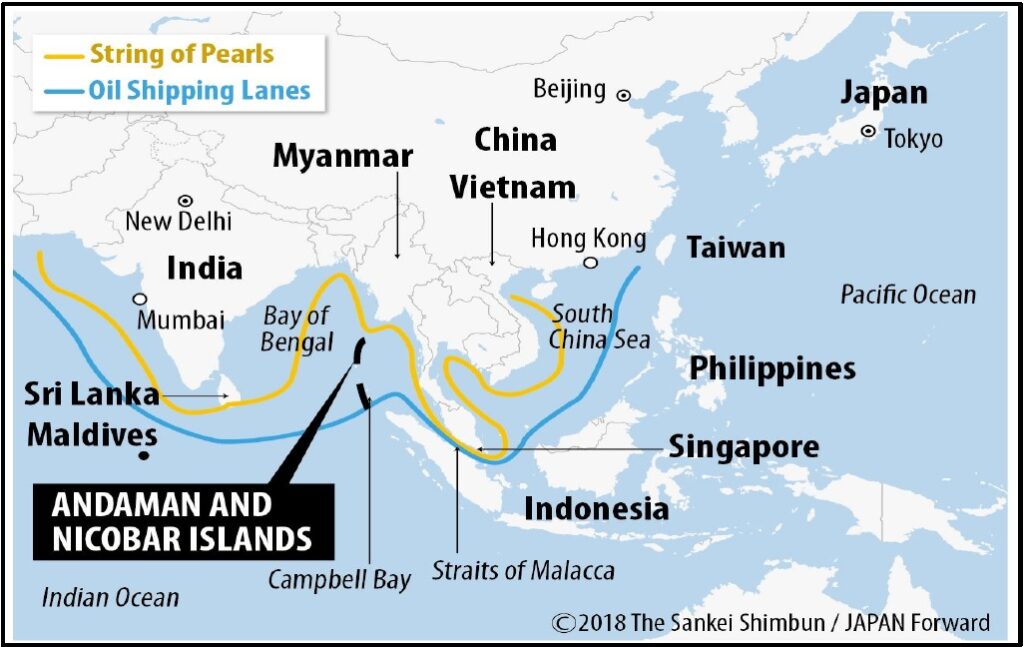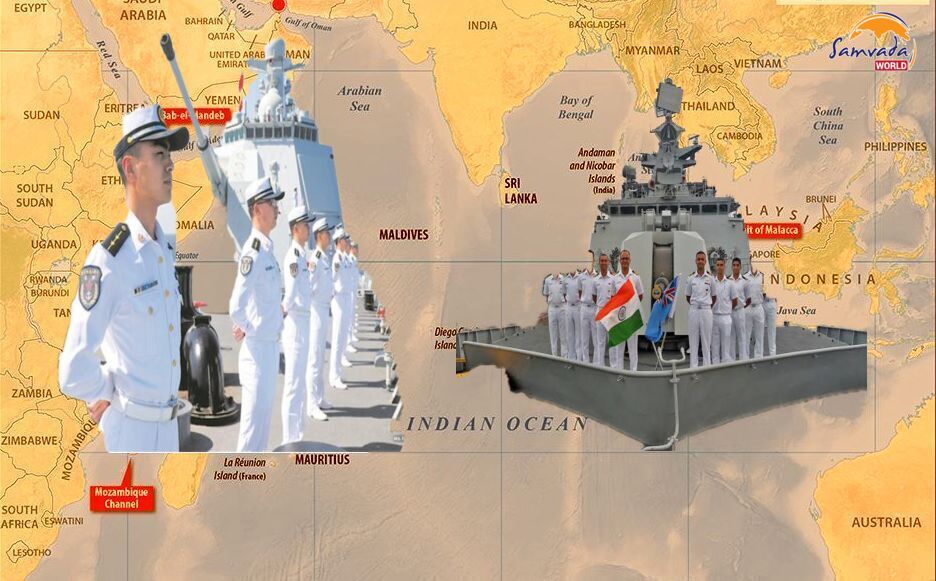
- Under the label of development, China’s ‘String of Pearls’ has set up commercial and strategic bases in several states.
- Strategically, the archipelago of ANI can help India to counter the growing Chinese assertiveness in the Indian Ocean.
- India has further adopted the ‘Necklace of Diamonds’ and ‘Double Fish Hook’ strategies to counter China’s ‘String of Pearls’ Policy.
- Indian government’s policies on the ANIs have been to end the isolation and make the archipelago a hub of economic and security activities.
Andaman and Nicobar Islands (ANIs) are an archipelago, i.e., a chain of islands nearly 1500km from mainland India. It lies in the Bay of Bengal Sea and consists of 836 islands, of which only 38 are inhabited. The Great Nicobar is separated from the Indonesian Aceh Province, located in the proximity of the Strait of Malacca, by the 6th-degree channel. The island chain accounts for 0.2 per cent of India’s landmass and contributes around 30 per cent of India’s Exclusive Economic Zone (EEZ). Yet, the islands have been victims of neglect for decades on the pretext of protectionism.
Economically, the island has an abundance of natural resources. Besides huge evergreen and semi-evergreen forest covers, the islands are surrounded by coral reefs and pristine beaches. Scientists have also discovered hydrocarbon reserves in these islands, boosting their economic value. Another way ANIs can serve India’s interests is through a trans-shipment port. If developed properly, these islands can compete with Singapore and Colombo ports in refuelling, unloading and stocking, and maintenance purposes of large ships. The Indian Ocean is a critical sea lane of communication, accounting for about 80 per cent of the world’s maritime trade. Therefore, developing and safeguarding ANIs becomes crucial for India to assert its dominance in the Indian Ocean Region (IOR).
Post-Cold War, the Indian Ocean emerged as an active theatre in the bigger game of Indo-Pacific. In 2013, China launched its Maritime Silk Road (MSR) initiative under the Belt and Road Initiative (BRI) Project. According to MSR, China planned to invest in development and infrastructure projects throughout Southeast Asia, Oceania, IOR and East Africa. Over the years, China’s presence in the Indian Ocean has increased. It is not similar to the presence of other powers like the US, Great Britain and France because it undermines India’s maritime sovereignty by cunningly entering Indian waters under the anti-piracy escort group activities, scientific research or satellite launch events.
Under the label of development, China’s ‘String of Pearls’ has set up commercial and strategic bases in several states. China has lured and trapped developing nations like Kenya, Djibouti, Sri Lanka, Myanmar, and many more by providing unsustainable development and infrastructure loans. The acquisition of ports and land in these countries under debt-trap diplomacy is evidence of Chinese intentions to establish its dominance in the IOR. The acquisition of Sri Lanka’s Hambantota Port for 99 years is a prime example. Other instances include Pakistan’s Gwadar Port, developed under China Pakistan Economic Corridor (CPEC) Project, China-Maldives Friendship Bridge and Myanmar’s Kyaukpyu Port. Apart from infrastructure projects, China has also invested heavily in satellite surveillance technology. Through ‘BeiDou-2&3 Satellite Constellation’, China has increased its surveillance capabilities in the IOR, threatening India’s position.
Strategically, the archipelago of ANI can help India to counter the growing Chinese assertiveness in the Indian Ocean. The ANIs are located at the choke point of the Strait of Malacca. China’s 70 per cent of the oil supply and 60 per cent of total trade pass through the strait. In an unfortunate event of aggression between India and China, India can strategically block Chinese access to oil and essential commodities, delivering a significant blow to its economy with the help of the island chain. Perhaps it is for this reason that the ANIs are also called the ‘Great Indian Wall Against China. The responsibility of this task lies with the country’s ‘Eastern Naval Fleet’ in Visakhapatnam and ‘Tri-Services Command’ at ANIs. Thus, the islands can help India become a regional maritime power. Furthermore, the islands can also provide a push towards India’s ‘Act East Policy’ by enhancing cooperation in the East and South East Asia region.
Under PM Modi's administration, the policy of isolation was reversed in the 'Shangri La Dialogue', acknowledging the interests and importance of external navies in the IOR.
To protect its strategic interests and enhance interoperability among forces (Army, Navy and Air Force), India set up its first Tri-Services Theatre Command at Port Blair in 2001. India also conducted a ‘Bull Strike’ exercise to strengthen coordination among its forces in the ANI. Before 2014, India was hesitant to allow naval vessels from any state to enter the islands, which can be attributed to India’s attempt not to antagonise China or safeguard its interests against forcing complex strategic demands from external navies on India. However, under PM Modi’s administration, the island group received renewed focus. The policy of isolation was reversed in the ‘Shangri La Dialogue’, acknowledging the interests and importance of external navies in the IOR. The policy also aligned with India’s ‘Security and Growth for All in the Region’ (SAGAR) Initiative, which aimed at various issues, including defence and security capabilities, collective action among littoral states, sustainable development, and more.
India has further adopted the ‘Necklace of Diamonds’ and ‘Double Fish Hook’ strategies to counter China’s ‘String of Pearls’ Policy. Under this strategy, India aims to counter China’s encirclement strategy by developing naval bases across crucial Indian Ocean states. India’s counter plan is evident through its new naval bases, such as Assumption Islands in Seychelles, Chabahar Port in Iran, Sabang Port in Indonesia, Changi Port in Singapore and Duqm port in Oman. ANIs are also a crucial part of this strategy. So far, India has developed three naval air stations in the islands: INS Utkorsh in Port Blair, INS Baaz in Great Nicobar and INS Kohassa in North Andaman.

Traditionally, India has focussed more on the Andaman Islands, but recently the government has launched the ‘Greater Nicobar Development Plan’ to develop the Nicobar Islands at par with the Andaman Islands. The Great Nicobar Island lies on the East-West International Shipping Corridor, connecting East Asia through the Strait of Malacca to Suez Canal and western Europe, providing India with a substantial economic development opportunity. Under the plan, India will develop an airport complex and transhipment facilities in Galathea Bay. To further strengthen India’s naval capabilities and promote maritime diplomacy, the government jointly conducted exercises with partner states in the ANIs region, including Indo-Indonesia Corpat Exercise, Singapore – India Simbex Exercise, and so forth. India has signed several agreements with Australia, France, Singapore and South Korea to provide logistics support, enhancing the capacity of Indian naval forces.
Traditionally, India has focussed more on the Andaman Islands, but recently the government has launched the 'Greater Nicobar Development Plan' to develop the Nicobar Islands at par with the Andaman Islands.
The establishment of Quad is also a positive development in terms of India’s strategic plans for the IOR. Quad (Quadrilateral Security Dialogue) is a group of four countries- the US, India, Australia and Japan- aiming to secure a free, open, inclusive and rule-based Indo-Pacific. India also took part in the Malabar exercise with the US and Japan to express its regional intentions. India no longer accepts the Chinese ‘bullying’ attitude at the land or maritime borders. India is prepared to cooperate with like-minded nations with overlapping security interests in the IOR to maintain a safe and secure sea with freedom of navigation and rule-based order. Australia has also stepped up to counter Chinese presence in the Indo-Pacific. India and Australia have agreed to mutually use Andaman and Nicobar Islands and Cocos Islands, providing better surveillance opportunities in the region which will help monitor the activities of the Chinese fleet. Japan, which once controlled the ANIs during World War II, has now offered great assistance to India. Under its ‘Official Development Assistance Program’, Japan has provided 36 million USD in financial aid for improving the power supply in the islands. Japan has also promised to invest 610 million USD in India’s north-eastern region under the ‘Japan-India Act East Forum’ Pact to ensure regional connectivity.
Indian government’s policies on the ANIs have been to end the isolation and make the archipelago a hub of economic and security activities. India has set up its 3rd Naval Fleet and increased the presence of its troops in the islands. Better regional connectivity and military upgradation will go a long way in favour of India. India needs to develop a coordinated response while maintaining strategic autonomy and develop the region through highly integrated policies to strengthen its hold and counter the growing Chinese influence in the Indian Ocean.
(Rahul Ajnoti is a Post Graduate Politics and International Relations student at Pondicherry University. His areas of interest include India’s Foreign Policy, South and South East Asia, Environment and Feminist Studies. Views expressed are the author’s own.)
